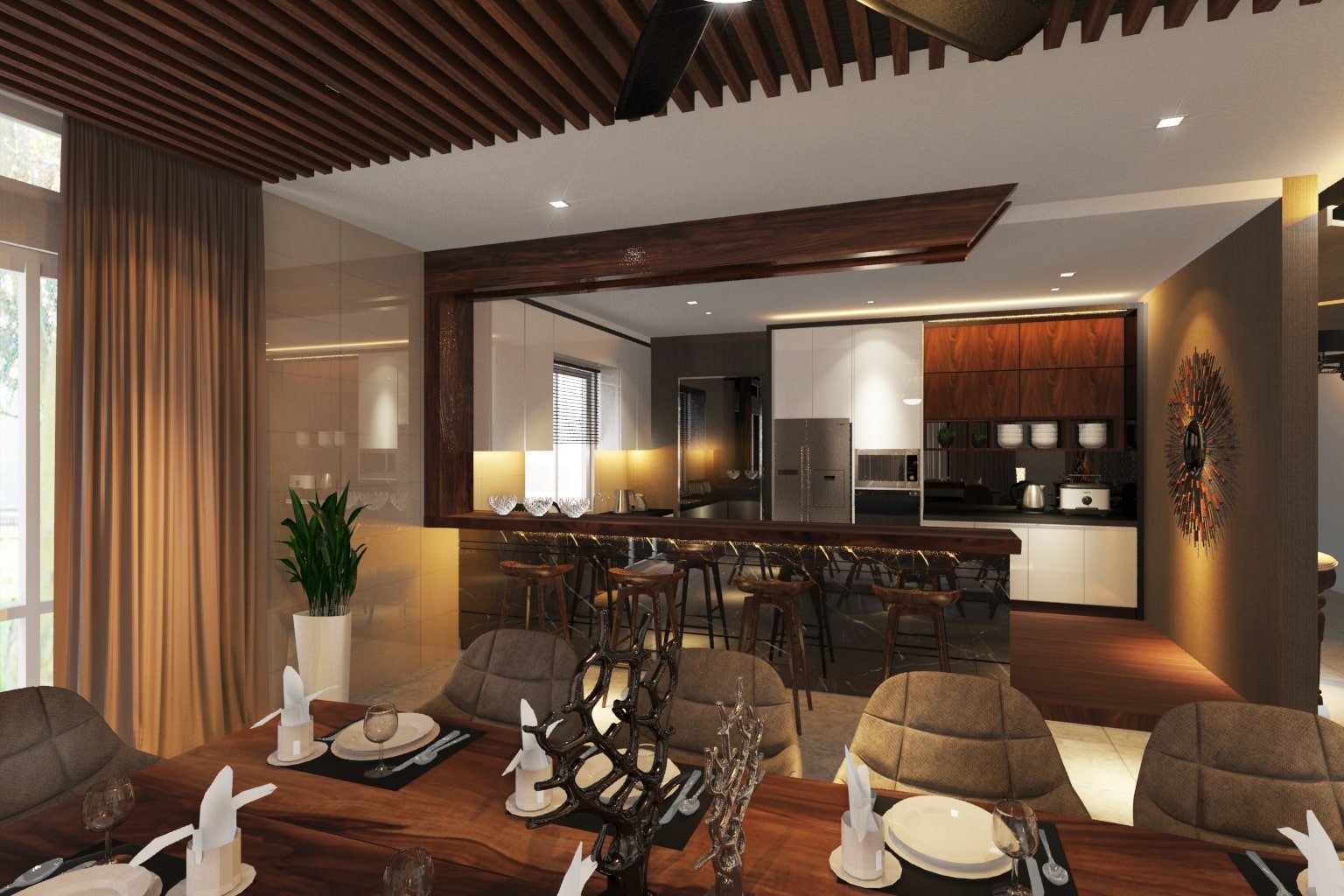Affordable interior design or budget-friendly interior design service is no longer novel in our country. Companies claiming to help you save up to 70%, promising to deliver high-quality work within just 30 days, are tempting.
However, beneath the surface of these offers lies a host of challenges—hidden costs, substandard materials, and unsustainable practices—that ultimately undermine the long-term value of your investment.
The Trade-off Between Cost and Quality
While budget-friendly interior design services may seem like a dream come true, they come with significant trade-offs—most notably, the compromise between cost and quality.
Substandard Materials
To cut costs, these companies often rely on cheaper, low-quality materials. While this may not be apparent at first glance, over time, it becomes painfully obvious.
Cabinets may warp, flooring might scratch easily, and paint finishes may begin to chip sooner than expected. What was supposed to be a “high-quality” renovation quickly shows its flaws, forcing homeowners to spend even more on repairs or replacements sooner than anticipated.
Short-term Solutions vs. Long-term Value
Budget services tend to prioritize speed and affordability, often focusing on short-term, surface-level fixes rather than durable, long-lasting solutions.
While you may initially save money, the lack of emphasis on durability and craftsmanship means you will likely need additional renovations down the line.
In contrast, higher-end services that invest in quality materials and craftsmanship offer long-term value that pays off over time, both in functionality and resale value.
Limited Customization
Budget-friendly design services often rely on template-based designs and standard fixtures that may not suit every homeowner’s needs.
These firms rarely have the flexibility or resources to tailor designs to your specific tastes, preferences, or lifestyle requirements.
This cookie-cutter approach limits the ability to create a truly unique and personalized space that reflects your individual style or optimally utilizes your space.
Ultimately, the initial savings these companies promise are offset by the long-term costs of repairs, replacements, and lost value, making it clear that the trade-off between cost and quality is rarely worth it.
Hidden Costs and Unexpected Surprises
The promise of a low upfront price is a key selling point for budget-friendly renovation firms, but homeowners often find that what they initially save gets eroded by hidden costs and unexpected expenses.
Scope Creep
One common issue is scope creep—where the initial project estimate doesn’t account for additional work that “unexpectedly” arises during the renovation process.
The base price may cover the most basic aspects of the job, but once work begins, homeowners are often presented with additional costs for items that should have been accounted for from the start.
What seemed like a budget-friendly project quickly balloons into an expensive ordeal.
Repairs and Replacements
Another significant hidden cost comes in the form of repairs and replacements due to poor workmanship. Budget services often cut corners by hiring less-experienced workers or skipping crucial quality checks.
As a result, issues such as leaky pipes, misaligned doors, or poorly installed flooring become apparent soon after the project is completed.
These problems often require immediate attention, costing homeowners more money to fix—sometimes negating any initial savings altogether.
Short Life Cycle
Cheap renovations generally have a shorter life cycle. As mentioned earlier, poor-quality materials and workmanship mean that these renovations need to be replaced or repaired more frequently. This leads to more construction waste and increased consumption of resources.
In contrast, sustainable, higher-end designs prioritize durability and materials with a longer life span, reducing the need for repeated overhauls and minimizing the project’s environmental footprint.
Lack of Attention to Detail and Expertise
Budget-friendly renovation services often focus on getting the job done quickly and cheaply, but this approach leaves little room for the critical aspects of design that ensure a project’s success.
The lack of attention to detail and professional expertise can result in a space that feels incomplete, poorly executed, or outright dysfunctional.
Cutting Corners
In their quest to minimize costs and speed up completion times, these firms often cut corners. Critical steps like proper space planning, structural analysis, or safety checks may be ignored or rushed.
As a result, you might find poorly installed fixtures, mismatched materials, and awkward layouts that affect the functionality of your home.
Moreover, certain safety standards may be compromised, putting both your home and its occupants at risk in the long term.
Inexperience of Workers
To save on labor costs, budget design firms often employ less-experienced workers or subcontractors who may lack the training and skills required for specialized tasks.
These workers may not be up to speed with industry best practices or new design trends, leading to subpar finishes and craftsmanship.
In some cases, the lack of expertise results in major mistakes that can ruin the entire project—walls built unevenly, wiring improperly installed, or plumbing done without adequate attention to codes and regulations.
Aesthetic Compromise
Design is not just about function; it’s also about form and style. Budget services often fail to deliver the level of refinement and creativity you would expect from more professional, higher-end firms.
Designs are often basic and uninspired, relying on cookie-cutter templates instead of original or customized ideas. This lack of creativity can leave you with a space that feels generic or lacks personality, ultimately reducing the enjoyment and utility of the room.
When choosing a service based purely on price and speed, the attention to detail and expertise necessary for a successful renovation often get lost in the process, leaving you with an underwhelming final product.
Poor After-Sales Support and Warranty Issues
Another often overlooked downside of budget-friendly renovation firms is the lack of adequate after-sales support and the limited warranty coverage they offer.
While these services might be fast and cheap upfront, the real problems start to arise when something goes wrong after the project is completed.
Limited Warranty Coverage
Budget renovation companies typically provide very limited warranties, if any at all. Even if they do offer one, it’s usually short-term and doesn’t cover the full scope of potential issues that can arise from poor-quality workmanship or substandard materials.
For example, the warranty may only last for a few months, covering basic repairs, but it likely won’t protect you from major structural or functional issues that arise later.
By the time problems like leaking faucets or malfunctioning electrical outlets appear, the warranty has usually expired, leaving you to cover the repair costs.
In contrast, high-quality interior design services often include turnkey solutions—a comprehensive service package that extends well beyond project completion.
These firms typically offer longer and more comprehensive warranties, covering a wide range of potential issues that may arise post-renovation.
Their turnkey approach ensures that clients receive end-to-end service, from initial consultation to post-project support, providing peace of mind.
Lack of Accountability
Once the project is completed, many budget renovation firms tend to disappear, offering little to no follow-up or aftercare.
If issues or defects surface after completion, homeowners often find it challenging to get the company to take responsibility. Budget firms may avoid answering calls, delay follow-up appointments, or simply refuse to address complaints.
This leaves homeowners with no option but to hire another contractor to fix problems that should have been addressed from the start.
On the other hand, reputable design services pride themselves on maintaining ongoing relationships with their clients. Even after completion, they are readily available to handle any follow-up issues, ensuring that the renovation remains functional and aesthetically pleasing over time.
Inconsistent Customer Service
Because these firms operate on tight margins, customer service is often not a priority. The focus on volume and speed means that once your project is done, the company quickly moves on to the next client, leaving little room for personalized care.
If you do manage to get in touch with them for after-sales support, the response is often delayed, and the quality of service is inconsistent.
Choosing a budget-friendly firm may seem like a cost-saving solution at first, but the lack of proper warranty coverage and poor after-sales support can result in long-term frustration and unplanned expenses, making it far from the hassle-free experience many expect.
Key Takeaways
In a market saturated with budget-friendly renovation options, it’s easy to be lured by promises of significant savings and rapid results.
However, as we’ve explored, the true costs often extend far beyond the initial price tag. From compromised quality and hidden expenses to environmental concerns and inadequate after-sales support, the pitfalls of choosing cheap interior design services are numerous and substantial.
Choosing quality over affordability might require a larger upfront investment, but it pays off in the form of durability, satisfaction, and peace of mind.
By prioritizing sustainable practices and thoughtful design, you can create a space that not only enhances your lifestyle but also contributes positively to the environment.
As you consider your renovation options, remember that the best choice is one that balances aesthetics, functionality, and sustainability, ensuring that your home remains a cherished sanctuary for years to come.


